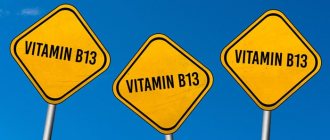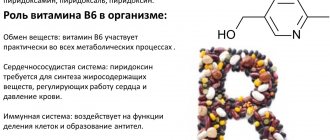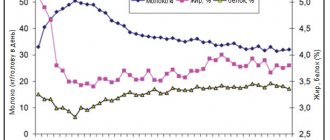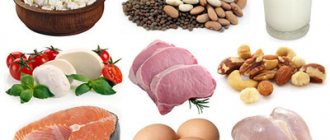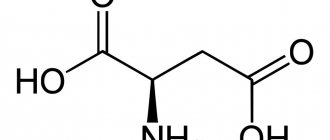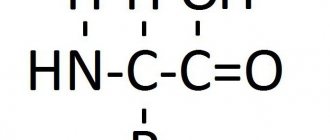L glutamine is the most common amino acid in the human body. It is present in large quantities in the blood, and spreads through it in the body, accumulating in the muscles. 60 percent of human muscle is made up of glutamine. For this reason, glutamine is often used as a nutritional supplement for muscle building and long-term sports training.
But many novice athletes, not understanding what glutamine is, begin to take it in large quantities and without following certain rules. Which will never give a good result.
What is glutamine
In order to answer the main question - what is glutamine, you can go to the sports encyclopedia website - SportWiki.
As defined by this resource, L-glutamine is a class of amino acids that are a constituent of proteins and are designed to enhance muscle growth performance. Also important properties of glutamine include its assistance in supporting the human immune system.
Glutamine is formed due to the breakdown of proteins in the human stomach and intestinal tract, under the influence of enzymes. Then it penetrates into the blood and is consumed by the muscles, as well as other tissues of the body. In addition to glutamine, 21 other amino acids are produced during the breakdown of proteins. These amino acids have the ability to connect with each other through peptide bonds to form proteins. Which contribute to the appearance and development of muscle fibers.
Reasons why you need to consume enough glutamine. This:
- maintaining immunity;
- increasing the body's endurance;
- optimization of protein metabolism and much more.
This element belongs to the conditionally essential amino acids. This implies that under normal (quiet) conditions, glutamine is produced by the body itself in the required quantity. But under the influence of strong and long-term stress, or any other external factors, the human body cannot produce it in sufficient quantities. In such cases, you can compensate for the loss of glutamine by eating foods containing this amino acid in large quantities. Or use glutamine directly, in its various variations.
What is glutamine for?
Without understanding why it is needed, glutamine should not be taken. After all, replenishing lost amino acids is one of the important points in the nutrition of athletes.
Glutamine is one of the most important amino acids in the body. Since, unlike other amino acids, it not only has a positive effect on the production of muscle fibers, but also has a number of other useful functions. Namely:
- does not allow the process of muscle destruction (catabolism process);
- increases the amount of growth hormones;
- provides energy saturation, thereby increasing endurance;
- promotes rapid recovery of the body after prolonged training (by reducing acidity in muscle tissue);
- creates favorable conditions for those who plan to lose weight while maintaining muscle mass;
- has a beneficial effect on the functioning of the stomach and intestinal tract;
- improves the body's detoxification process;
- increases blood flow to the brain, helping to improve mental activity;
- actively participates in strengthening the human immune system.
Glutamine is often used for weight loss. Since it promotes natural fat burning, which, together with an increase in metabolic rate, leads to good results.
In sports, for both men and women, the factor of recovery after grueling training, illness and diet is important. Since all these factors are accompanied by physiological stress and reduce glutamine reserves in the body, the recovery process is slow. And to speed it up, it is necessary to increase the amount of this substance in the body. To achieve this, athletes drink glutamine, which also helps form protein.
Effect on protein synthesis in muscles
It is a widely known fact that during the process of insulin release, carbohydrates are converted into glycogen. But few people know the fact that glycogen depots (transport cells) consist of proteins. For this reason, the amino acid glutamine allows you to greatly increase the number of these cells. As a result, there is the possibility of greater accumulation of glycogen in the body, which leads to:
- increasing endurance;
- increasing muscle volume;
- reducing excess energy stored in fat cells;
- opening of glycogen reserve stores.
The use of this amino acid allows you to create many germ cells during the insulin window. For athletes during the initial period of sports, this fact will not provide any tangible help in gaining muscle mass. But when an athlete reaches a developmental ceiling at a certain level, glutamine will allow him to make a qualitative leap and overcome a period of stagnation.
Main effects of glutamine
There are many different facts about the benefits and harms of glutamine for the human body. Some of them are confirmed by various studies. But the majority are just assumptions, conjectures and myths. So it is necessary to carefully separate the grains of truth from the rest of the husk of rumors and errors.
Thus, it is known for sure that the main effects of this amino acid include a positive effect on results during intense exercise and overall strengthening of the immune system.
It is worth noting that some experts question the beneficial properties of this and other amino acids. Citing as an example the tests conducted, where the first group engaged in physical training with glutamine intake. And the other with a placebo. According to the results of the study, the results of the two groups were not significantly different. Which led to the conclusion that taking this substance is inappropriate.
But it is worth noting that the results were highly averaged. And also the amount, time and mode of taking glutamine is individual for each person. After all, it is better for some to take it after training, and for others before bed or at other times. And this approach plays a key role in the success of training.
L-glutamine Extreme
An innovative complex with glutamine designed to eliminate interference with muscle regeneration. One package is enough for more than a month of consumption, even taking into account the fact that the body uses the main substance in large quantities and quite often. This complex combines classic L-glutamine with N-acetyl L-glutamine for even greater effectiveness. The Extreme product is only suitable for experienced athletes, as this blow will be too big for beginners.
Along with the packaging, the buyer is provided with a special measuring spoon. This is what you need to use to scoop up the mixture (one serving is a full spoon without a slide). In total, you should take the supplement three times a day, 4 grams (spoon) and wash down with 300 ml of plain water. On training days, the first portion should be immediately after waking up, the second after exercise, and the third before bed. On rest days, only the time of taking the second serving changes - here it must be consumed between lunch and afternoon snack. You are allowed to start eating after the amino acid only an hour later.
View gallery
The price of the product is 2 thousand rubles.
What foods can amino acids be found in?
Since when glutamine is severely depleted in the body, restoring its amount is difficult, there is a need to help your body. To do this, the missing volume of this substance can be replenished from food.
Sources of glutamine in foods are:
- beef and pork;
- hard and processed cheeses;
- kefir and cottage cheese;
- cod and sea bass;
- chicken and goose fillet;
- soy products and corn.
Glutamine contained in sports nutrition has the same properties. But some people are skeptical about this type of product. Although they are more preferable for weight loss.
Admission rules
The ideal option is to consume glutamine on an empty stomach. Experienced trainers recommend doing this about half an hour before meals. This is explained by the fact that the amino acid needs time to be absorbed by the body, since when other food products are consumed, other important elements come along with them, and at the same time with glutamine it will be much more difficult for them to be absorbed.
View gallery
Difference between glutamine and glutamic acid
Due to the fact that glutamine and glutamic acid (glutamate) are very similar in their chemical structure, many people confuse them and even say that they are the same substance. But this is a big mistake.
Glutamic acid is obtained as a result of the breakdown of glutamine. The reverse process is also possible by adding an ammonia molecule to this acid. It follows from this that these are two different substances, and the functions they perform are also different.
Glutamic acid is an excitatory, neurotransmitter acid. And it is used to improve the activity of brain function by reducing the amount of ammonia in the brain. Since this element inhibits brain activity.
Glutamine, being a component of protein, is most often found in free form in human muscles. And has many other beneficial properties mentioned above.
Beneficial properties of the amino acid glutamine
The benefits of glutamine are underestimated by many people. This substance is the best source of nitrogen in the human body. The range of uses of this amino acid is very wide: from treating gastrointestinal disorders to reducing the impact of alcohol and drug addiction.
The effect on the body affects areas of the brain. As well as many other organs, such as the stomach, liver, intestines, muscle tissue and the immune system. All of these areas are negatively affected by a lack of glutamine. So it is necessary to constantly maintain its balance, because under heavy loads and stress the human body is not able to fully restore the loss of this substance.
Leaky gut and ulcers
Millions of people struggle with a condition called leaky gut , which is a leading cause of autoimmune diseases . Leaky gut can cause thyroid problems, Hashimoto's disease, arthritis, skin conditions such as psoriasis, atopic dermatitis and other serious health problems.
Because glutamine is the main source of fuel for small intestinal cells, it has been shown to heal leaky gut . A study published in the medical journal Lancet looked at 20 hospital patients and found that L-glutamine supplementation reduced intestinal permeability ( ). An animal study published in the British Journal of Surgery found that L-glutamine was beneficial for ulcerative colitis and inflammatory bowel disease. ( )
It can also help treat ulcers, providing protection against further damage, and also offers a healthier, natural alternative to antibiotics for treating stomach ulcers. ( )
If you're not sure whether you have leaky gut or not, take a leaky gut test . If you do have leaky gut, L-Glutamine is the #1 amino acid you need to heal and repair it.
How and when to take
There are several ways to take glutamine. And not everyone is suitable for one or another method of administration. The time and duration of use, as well as the dosage of glutamine, are individual for each person. Additionally, they depend on the following factors:
- the reasons why this substance is taken;
- desired result;
- on age and body weight;
- amino acid consistency.
The most common times to take glutamine are in the morning on an empty stomach, before and after exercise, and before bed.
But no matter what time you take this substance, you must carefully read its description and use the instructions for reconciliation.
Glutamine comes in powder and capsule form. It can be taken alone or combined with creatine.
Use with creatine
Since the effect of glutamine has already been discussed above, it is worth noting what creatine is needed for.
Creatine promotes metabolism in nerve and muscle fibers, and is often used in the nutrition of athletes. By taking this substance you can achieve:
- development of muscle mass;
- improvement of strength indicators;
- increasing endurance;
- reducing recovery time;
- appearance of muscle relief;
- preventing the formation of lactic acid.
And due to the fact that the tasks performed by creatine and glutamine are largely similar, they can be combined when used. An important role in simultaneous administration is played by the fact that glutamine additionally serves as a transport substance for creatine.
Experts advise doing the following with glutamine: consume 10 grams per day, dividing the intake into two times (5 grams each). Take after training and before bed. And if training is not planned - during lunch and before bed. Set the creatine dose to 7 grams per day, after training. On non-workout days, take it in the morning.
Taking glutamine capsules
After determining your daily dose, you need to decide how to take glutamine. You can choose to take glutamine capsules. This method of administration is convenient because it quickly breaks down when it enters the stomach, unlike tablets. It is also easy to use, since the dosage is measured and standardized.
The capsules can be taken directly with water or sprinkled into a cocktail or meal.
How to take glutamine powder
The next type of substance consistency is powder. Its peculiarity is that it ensures the fastest penetration of amino acids into muscle fibers.
But there is also a disadvantage of powdered glutamine - you will have to measure the portions yourself. And if you are not careful, it is easy to make a mistake with the dosage, which will not give the required result.
The consumer should not have any problems taking glutamine powder. It can easily be added to food during lunch or breakfast. Mix into a post-workout protein shake. Or consume it at night, directly, with plenty of water.
How to Take Glutamine with a Protein Shake
The taste of the amino acid can be significantly improved. To do this, you need to mix a protein shake and glutamine together. Some people are afraid to mix the amino acid into a shake because they don't know if it's the right way to take glutamine this way.
To do this, you need to divide the daily intake of the product into 4 equal parts and add it to a protein shake, which is easy to prepare at home. Take the mixture in the morning, before and after training, and before bed.
Dipeptide L-alanyl-L-glutamine (AG): properties, metabolism and effectiveness
It has now been established that polypeptides are broken down under acidic and enzymatic action in the intestinal lumen to oligopeptides, peptides consisting of two or three amino acids and to free amino acids. The resulting di- and tripeptides accumulate in significant quantities in the cytosol of cells (enterocytes) of the intestinal mucosa. Some of these peptides are hydrolyzed to free amino acids, but some di- and tripeptides are able to survive cytosolic hydrolysis and be transported intact across the basolateral membrane, attaching to the transport protein PepT1 - a proton (H+)-coupled cotransporter (36). Getting mainly into the venous blood of the portal bloodstream and further into the liver, as well as into the lymph. That. When administered orally or enterally, AG acts locally in the gastrointestinal tract to both protect the integrity of the intestinal mucosa and maintain intestinal barrier functions. These effects are the basis for the positive influence of hypertension - maintaining and/or restoring integrative intestinal function, normalizing nutrient absorption, preventing and inhibiting the possibility of developing exhaustion syndrome (increased lean body mass - LBM), correcting the metabolic balance by enhancing anabolic and inhibiting catabolic processes in muscle, pulmonary and nervous tissues.
In this regard, among the “urgent effects” of the AG dipeptide, it is reasonable to highlight the actions of AG associated with the acceleration of the body’s rehydration processes under high, prolonged loads - preservation of performance for a longer time and with high efficiency is observed. In addition, hypertension provides a significant ergogenic benefit by increasing exercise tolerance under conditions of moderate hypohydration stress (37–40). At the same time, a number of studies note that AG not only exceeds the free form of L-glutamine in terms of absorption rate in the intestine by more than two times, but also retains this ability in case of systemic chronic inflammation and decreased gastric secretion. In general, such features of the action of AG may have direct practical significance for the use of the dipeptide in clinical and sports medicine.
A number of studies have found that rapidly dividing cells, including cells of the intestinal mucosa, pancreas, pulmonary alveoli and cells of the immune system, use glutamine for energy and plastic needs. And for cells of the gastrointestinal tract (enterocytes, colonocytes), glutamine is the main source of energy (33, 41).
Intracellular oxidation of glutamine produces ATP, the most important molecular form of chemical energy storage and use in cells. The total amount of energy stored depends on the availability of glutamine and the degree of its oxidation. Under stress, this is determined mainly by the level of glutamine deficiency, the availability of glucose as an alternative source of energy in some tissues and the phase of the cell life cycle. For example, lymphocytes utilize glutamine for energy to a greater extent following mitogenic stimulation (41). Under physiological conditions, glutamine oxidation provides about 1/3 of the energy in rapidly dividing cells (42); under severe stress and pathological reactions, glutamine oxidation may increase.
The functioning of the immune system also depends on the availability of glutamine. Stress, causing glutamine deficiency, impairs the function of the immune system. The consumption of glutamine by cells of the immune system increases 10 times compared to other cells.
The functioning of the immune system also depends on the availability of glutamine. Catabolic stress, causing glutamine deficiency, impairs the function of the immune system. It has been shown that glutamine consumption by proliferating cells of the immune system is increased 10-fold compared to other cells (43, 44,45).
Glutamine is an essential substrate for the normal functioning of humoral and cellular immunity. Thus, in vitro studies have shown that glutamine deficiency in tissue culture media severely limits the ability of lymphocytes to respond to mitogenic stimulation (46). In addition, some inflammatory mediators (interleukins, etc.) and glucocorticoids increase the activity of glutaminase in lymphocytes, including in the mesenteric lymph nodes, which leads to increased utilization of glutamine.
Consequently, the use of a unique exogenous intestinal transporter in the form of an AG dipeptide molecule can cover a possible relative deficiency and more effectively increase the reserve amount of glutamine in the bloodstream, intercellular space, skeletal muscles and cells compared to conventional free G. When AG is administered, a higher level of concentration is maintained in glutamine compartments: blood plasma, lymph, intercellular space and skeletal muscles, compared with the introduction of free G. This feature of the biodistribution of AG is very important, since up to 65% of free G administered orally can be destroyed before it reaches the muscles. It can be assumed that in a healthy body there is a multi-parameter dynamic homeostasis of glutamine; it is balanced and configured in such a way that an unstable reserve amount of G is maintained. Current needs are satisfied due to the reserve and release of glutamine from the muscles and lungs through the breakdown of its own proteins, and the replenishment of the reserve comes from due to external inputs and increased denovo glutamine synthesis. G. is actively spent primarily on maintaining the normal structure and function of the intestinal mucosa, hepatic ammoniagenesis, proliferation of lymphocytes, other cells of the immune system, and muscle function. A decrease in intramuscular glutamine concentration causes a significant increase in the breakdown of muscle proteins. The total muscle glutamine reserve is relatively small (about 240 g), stress-induced breakdown of 1 kg of muscle tissue provides only 9 g of glutamine, so the catabolic release of glutamine is limited and insufficient with increasing demands. During catabolic stress in a 70 kg patient, glutamine consumption by the intestinal mucosa, kidneys and immune system is higher than the body can compensate through the breakdown of its own muscles and increased glutamine synthesis, by approximately 12 g/day. The real need for glutamine under stress and extreme loads is at least 18-22 g/day (45).
Hypofunction of skeletal muscles and exercise intolerance are distinctive clinical signs of patients with heart failure, coronary heart disease (CHD) and other pathologies of the cardiovascular system (CVS). They are generally associated to a greater or lesser extent with a progressive catabolic state, skeletal muscle inflammation, and impaired oxidative metabolism. For a long period of time, medical researchers and sports medicine specialists from different countries have been paying considerable attention to the search for means of optimizing the functioning of the cardiovascular system under high loads, drugs against coronary artery disease and heart failure, and special sports nutrition products. During the search, in particular, it was found that polyunsaturated fatty acids (PUFAs), such as omega-3, omega-6, omega-9 and others (more than 11), affect metabolism in the body, including at the cellular level. It turned out that PUFAs are not synthesized in the tissues of the body, but are necessary for its life. In particular, PUFAs protect cells from premature aging and help preserve their genetic information. Regulate fat metabolism and the vital activity of beneficial bacteria living in the intestines. In 2004, the US Food and Drug Administration (FDA) recognized that consumption of some omega-3 PUFAs (eicosapentaenoic acid (EPA), docosahexaenoic acid (DHA)) may reduce the risk of coronary heart disease. In the body, PUFA peroxidation is counteracted by antioxidant systems, including the tripeptide glutathione, which is synthesized from glutamine (47-51).
Dietary supplements, including fish oil containing the omega-3 PUFA polyunsaturated fatty acids eicosapentaenoic acid (EPA) and idocosahexaenoic acid (DHA), have been shown to reduce mortality in patients with chronic heart failure (53).
The effects of PUFAs were demonstrated by improvements in cardiac function, exercise capacity, and circulating cytokine levels (TNFα, IL-1, and IL-6) in patients with chronic stable heart failure (54).
In addition, as noted above, G not only participates in maintaining nitrogen balance homeostasis by changing the intensity of muscle proteolysis, but also in maintaining the synthesis of a powerful antioxidant and regulator of cell membrane integrity, glutathione, which probably prevents the rapid oxidation of PUFAs (56-58).
In blinded, randomized clinical trials in patients with advanced heart failure (HF), which is caused by the progressive development of metabolic disorders, inflammation and atrophy in the myocardium and skeletal muscle, it was shown that there is a clear metabolic transition from the use of normal fatty acids to the use of glucose in as the main energy substrate for the generation of ATP in the tricarboxylic acid cycle (TCA). This switch is thought to result from changes in the genetic program with decreased expression of the enzymes carnitine palmitoyltransferase (CPT)-1, medium-chain acyl-CoA dehydrogenase (MCAD), citrate synthase, and hence PUFA utilization (56,59).
This metabolic switch is observed in skeletal muscle with increased (glycolytically) type II muscle fibers and decreased (oxidatively) type I fibers (60). This intrinsic metabolic transition in skeletal muscle is hypothesized to contribute to the development of exercise intolerance.
In a study (56), patients received orally for a long-term period (1 and 3 months) either a combination of AG 8 g/day and fish oil (a source of PUFA) 6.5 g/day, or a combination of safflower oil and milk powder (placebo) in equivalent caloric content quantities. The study found that combined l-alanyl-l-glutamine and PUFA supplementation did not improve tested exercise performance, muscle biopsy properties, or muscle function, but did increase lean body mass and improve quality of life in patients with chronic stable heart failure. These and other data indicate the potential beneficial effects of high-dose PUFAs and the effectiveness of concomitant dipeptide antihypertensive supplementation in patients with chronic stable heart failure (61,62). The question of the mechanisms of interaction and the positive effect of AG and PUFA on the growth of muscle mass remains open: it is not clear whether AG (in general dipeptides) is a transporter of fatty acids into the cell, or whether it acts indirectly by influencing the aggregation of chains of fatty acid molecules with the formation of micelles and thereby facilitating them absorption in the intestine, or affects the absorption and biosynthesis of other physiologically active substances within cells.
The cellular mechanisms of action of PUFAs have been intensively studied but have not yet been determined, but it is believed that the omega-3 eicosapentaenoic acid (EPA) and docosahexaenoic acid (DHA) may act either directly or through metabolites such as eicosanoids (64).
In this regard, there is reason to consider the mechanisms of modulation of fatty acid oxidation in the intercellular space, within cell membranes and in the cellular cytosol by glutathione as a possible area of control of AG on the processes of catabolism and absorption of PUFAs. Tripeptide glutathione is a powerful systemic antioxidant that can predictably influence the utilization of PUFAs. Although there is currently no scientific evidence of the direct effect of PUFA consumption on the performance and level of physical fitness of athletes, some of the identified properties of omega-3 and omega-6 PUFAs indicate the possibility of a direct or indirect positive effect of fatty acids on the function of a number of organs and systems in during training, accelerate recovery, reduce the effects of muscle and ligament damage with short-term or long-term use, reduce inflammation, stabilize the performance of the cardiovascular and respiratory systems at rest and during exercise. AG favors this effect of PUFAs (65-68).
In turn, glutamine plays an important role in the regulation of glutathione synthesis. It has been shown that glutamine, by enhancing the formation of glutathione, causes cellular anabolic effects by increasing cell volume. Under stress, when some tissues have increased levels of cell-damaging free radicals, the need for glutamine increases (69).
Experiments on animals have shown the possibility of a direct effect of consumption of food enriched with AG on increasing the level of glutathione (GSH) in blood serum and liver tissue. The relationship between hypertension and glutathione (GSH) biosynthesis and the role of this relationship in liver protection were studied. Twenty male Wistar rats were used and randomly divided into two groups: one received standard parenteral nutrition (STD) and the other with or without AG for 7 days. Blood and liver tissue samples were examined after peritoneal injection of the hepatotoxin 5-fluorouracil (5-FU). It turned out that the concentration of glutathione (GSH) in the blood serum was significantly higher in the hypertension group than in the group with STDs and the GSH content in the liver tissue was 36.2% higher than in the group with standard nutrition. Rats in the group AH had a smaller increase in liver enzymes after administration of 5-FU, indicating a hepatoprotective effect of the dipeptide. Those. A standard diet supplemented with AG may protect liver function by increasing glutathione biosynthesis and preserving glutathione stores in liver tissue (70).
Reduced glutathione (GSH) is a tripeptide consisting of the amino acids L-glutamate, L-cysteine and glycine, it is the most effective antioxidant maintaining intracellular redox potential (or redox potential), which is the ratio of reduced to oxidized (GSSG) forms of glutathione (GSH/GSSG). Maintaining an optimal GSH>>GSSG ratio in a cell is critical for its normal functioning and survival. The glutathione system is a free radical scavenger and, in particular, prevents the development of intracellular oxidative stress. GSH protects cells from damage caused by the production of free radicals during exercise, especially when their levels exceed the body's ability to defend against them. GSH deficiency puts the cell at risk of oxidative damage (71–73).
The glutathione redox potential system not only ensures cell resistance to oxidative stress, but is involved in the mechanisms of utilization of polyunsaturated fatty acids with the subsequent synthesis of cytokines and eicosanoids. Eicosanoids are oxidized derivatives of polyunsaturated fatty acids - eicosotriene (C20:3), arachidonic (eicosotetraenoic, C20:4), timnodonic (eicosapentaenoic, C20:5). Eicosanoids are synthesized from omega-3 (ω-3) and omega-6 (ω-6) fatty acids. In general, omega-6 eicasanoids are pro-inflammatory. Food sources of polyunsaturated fatty acids include vegetable oils, fish oil and omega-3 fatty acid supplements. Eicosanoids are involved in a variety of processes such as muscle growth, irritation, and immune responses to injected toxins and pathogens. Eicosanoids are formed in almost all cells of the body. But GSH glutathione is depleted relatively quickly, especially under conditions of glutamine deficiency, and is restored relatively slowly (74-77).
Glutathione is consumed especially intensively in the kidneys, liver, intestinal mucosa and macrophages. The half-life of GSH (T1/2) in blood plasma is 2 minutes; in the kidneys 30-50 minutes, in the liver, intestinal mucosa and macrophages 2-3 hours; in the brain; red blood cells, spleen, lungs 2-4 days; in the lens of the eye for 2-8 days (78).
It can be expected that AG can not only influence the absorption and utilization of polyunsaturated fatty acids, the synthesis of cytokines and eicosanoids, the synthesis of glutathione, but also as a supplier of glutamine on the synthesis of fatty acids and membrane phospholipids occurring with the participation of glutamine metabolites, including the substrate of the Krebs cycle acetyl coenzyme A, which provides acetyl groups. It is believed that the entry of glutamine into muscle and liver cells increases their hydration and serves as an anabolic proliferative signal (79). Oral administration of antigens can alter the body's entire metabolic response to stress.
AG can also be used to correct energy metabolism: both to improve gluconeogenesis in the liver and to store glucose in the form of glycogen. In addition, the intracellular oxidation of glutamine produces ATP, which can be considered as an alternative source of energy under high loads.
Glutamine in bodybuilding
Nowadays, glutamine has become widespread in bodybuilding. The fact that this substance influences muscle growth, their resistance to destruction and the body’s endurance is no secret. For this reason, everyone already knows why athletes need glutamine.
When an athlete reaches a certain level, he begins to understand that his body is not able to fully restore the lack of amino acids on its own. Then he begins to add glutamine to sports nutrition to solve this problem.
But first, everyone should find out for themselves how much glutamine to take per day. The main factor determining the dose is the person's weight.
The main reasons why a bodybuilder needs glutamine is its help in gaining muscle mass and restoring the body. Also, after additional intake of this amino acid during drying, there is a chance to get rid of fat cells without affecting muscle mass.
But everyone is free to decide for themselves whether they need glutamine or whether they will continue training without this supplement.
How much to take glutamine
The dosage when taking glutamine should be carefully observed. A common way to determine how much to take a substance is to calculate the dose based on the person's weight. There are many formulas, the use of which allows you to determine the daily norm.
For example, multiply a person's weight by 0.3. The result obtained is the daily dose of glutamine.
But it’s worth finding out whether this formula is right for you specifically. Or it would be better to calculate the dose using another method.
Is there any harm
Proper use of glutamine does not harm the body. But every person knows that abuse has a negative effect. This is the case with this amino acid.
If the amount of glutamine taken per day is exceeded, negative consequences appear. Also, there are contraindications for athletes with intolerance to the component. People with serious kidney and liver problems should not drink it.
Side effects
Glutamine also has side effects. Excessive use of this substance results in:
- high nervous excitability;
- stomach ache;
- nausea and diarrhea;
- irritation of the oral mucosa and cracks in the lips.
But all these effects appear with prolonged abuse of glutamine. If this happens, you should take a break. And in the future it is worth reducing the dose of glutamine.
1. Improves gastrointestinal health
L-glutamine is good for your health if you have any digestive problems such as irritable bowel syndrome (IBS), inflammatory bowel disease such as Crohn's disease , ulcerative colitis , diverticulosis, diverticulitis, leaky gut or any other problems related to leaky gut (such as joint pain , rosacea, or any other type of autoimmune response). Because glutamine is a vital nutrient for gut repair, it is required in our diet on a regular basis ( ).
It is worth noting that the man known for discovering the Krebs cycle in the body, Sir Hans Adolf Krebs, a German-born British biochemist who shared the 1953 Nobel Prize in Physiology with Fritz Lipmann, was the first to recommend taking L-glutamine for intestinal problems . This is because he found that L-glutamine helps improve a healthy gut-related immune response And additional research confirms this conclusion.
A study published in the Journal of Clinical Immunology found that L-glutamine normalizes the action of the TH2 immune response , which stimulates inflammatory cytokines ( ). The effects of L-glutamine in these studies prove that it reduces gut inflammation and helps people recover from allergies and food intolerances .
Top Glutamine Supplements
Glutamine is produced both separately and as part of various nutritional supplements. Manufacturers of sports nutrition have not ignored this valuable component for athletes.
As an example, we note the following additives:
- Glutamine Powder from Optimum Nutrition;
- Ultra Pure Glutamine from VPX;
- Xtend by SciVation;
- Glutamine from Prolab;
- Micronized Glutamine by Higher Power.
Choosing the right drug
To choose the right supplement, you should pay attention to the quality of the manufacturer and not chase cheap products. It would be the right decision to read consumer reviews and listen to the opinions of experts.
Initially, it is worth purchasing a small volume of the drug, for example, Glutamine powder. And if the result is satisfactory, and there is no rejection, continue to purchase this product.
American products
L-glutamine Powder is a product from the well-known American company, which creates various supplements for athletes that do not contain unnecessary components. And this glutamine is no exception. The main benefits include preventing overtraining, improving the immune system, and normalizing the quality of recovery. L-glutamine Powder has pretty good reviews. Buyers consider the main advantage to be the ability to dissolve tablets in natural juices to obtain a richer taste.
One serving of the supplement contains exactly 5 grams of glutamine amino acid. It is not taken in its pure form - the tablet should be mixed in a glass of liquid (juice or water).
Such glutamine can even be used in combination with other sports nutrition, because in this way the products will strengthen each other. But it is worth remembering that there is no need to mix glutamine and protein. Most often, athletes combine it with creatine, and half an hour later they drink a protein shake.
The product can be purchased for 1,500 rubles.



